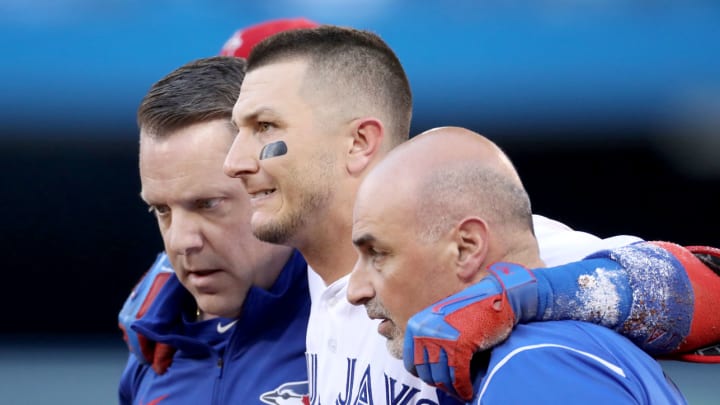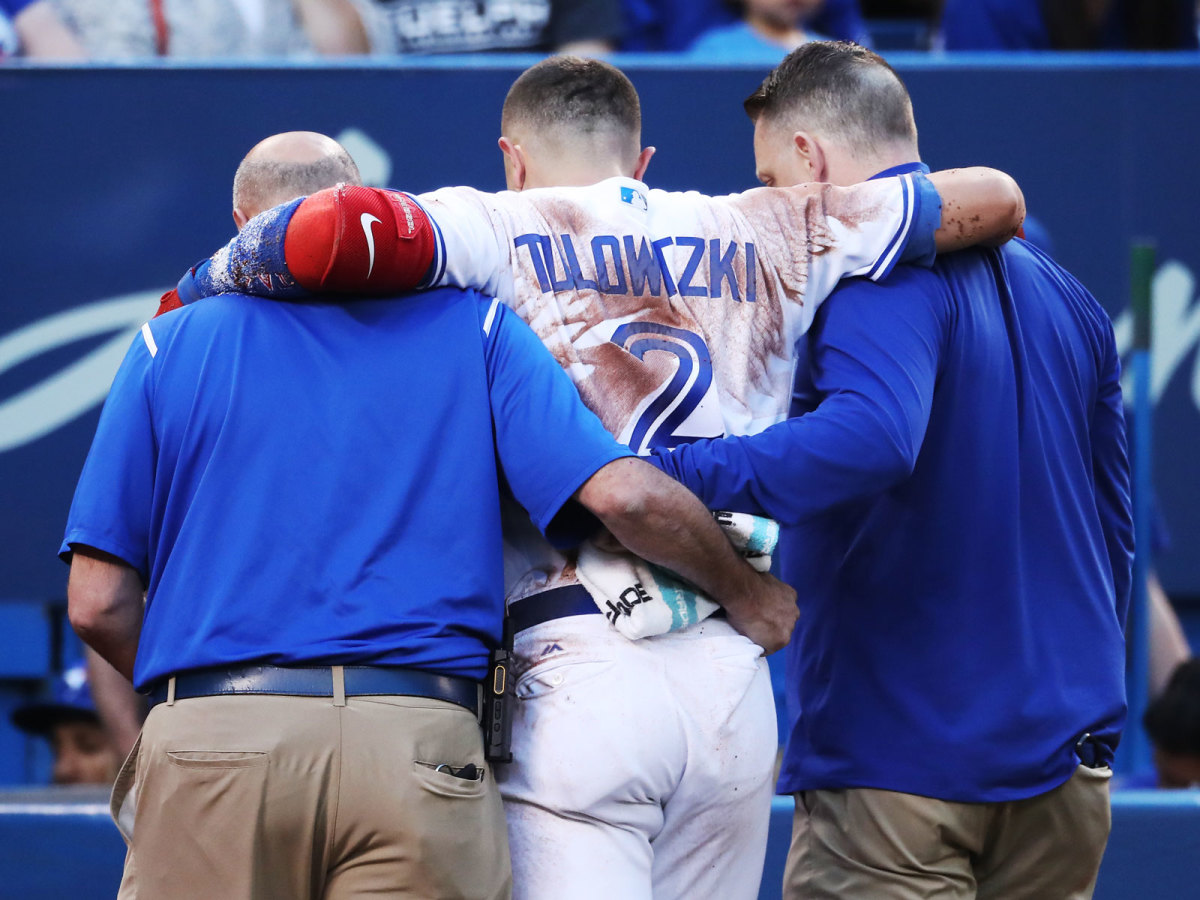Will Troy Tulowitzki Salvage His Career After Another Season Lost to Injury?

Troy Tulowitzki’s 2018 was over before it ever began. Last weekend, Blue Jays manager John Gibbons announced that the 33-year-old shortstop—who has missed the entire season to date due to bone spurs in both of his heels—is unlikely to return before the year concludes. This would be Tulowitzki’s second straight campaign to be limited (if not outright ruined) by injuries, further stalling his career since the July 2015 trade that sent him from Colorado to Toronto.
It’s been over a year since we last saw Tulowitzki on a major league diamond. Last July, he suffered a severe sprain of his right ankle running out an infield hit. That robbed him of what was left of the 2017 season after he’d played only 66 games; a late-April hamstring strain had cost him a month’s worth of games. By the time spring training rolled around, the Blue Jays were confident that Tulowitzki had recovered from his ankle injury and would be ready for the start of the season. But heel pain—reportedly the result of a bone spur in that injured ankle—kept him from playing in any Grapefruit League games. At the end of March, the team announced that he needed surgery on both his heels. That procedure was only supposed to cost him eight weeks, but after seven months of no results, Toronto has apparently pulled the plug.
“I went out to Florida, was out there on those back fields almost every day trying to go, and it just didn’t respond the way I needed to come back and play every day,” Tulowitzki told reporters last Sunday in Toronto.
It’s another stumble in what’s been a disappointing tenure for Tulowitzki, who came to Toronto in July 2015 from the Rockies to help with the team’s playoff push. Installed as the starting shortstop upon his arrival, Tulowitzki—who had hit .300/.348/.471 that year for Colorado—slumped to a .239/.317/.380 line with just five homers in 183 plate appearances. He also missed the last three weeks of the regular season with a small fracture in his shoulder.
Despite Tulowitzki’s poor numbers, Toronto soared in the second half that season, going 42–18 down the stretch to win the AL East, then taking out the Rangers in the Division Series before falling to the eventual world champion Royals in the ALCS. But while the Jays repeated their success in ’16, again reaching the ALCS (but again falling short of a pennant, this time swept by the Indians), Tulowitzki couldn’t replicate his past, hitting just .254/.318/.443 with a 102 OPS+—his lowest full-season mark in that category since 2008. Things got even worse the next year, as he fell to a .249/.300/.378 line before the ankle injury ended his season.
All told, Tulowitzki has contributed a mediocre .250/.313/.414 line across 238 games with the Jays—a far cry from the .299/.371/.513 mark he put up over nine-plus seasons with the Rockies. What the Jays and fans are left wondering now is if that decline is an injury and age-caused dip that Tulowitzki can rebound from, or if this level of production is the new normal going forward.
Tulowitzki still believes he’s still the same All-Star-caliber shortstop he was in the past, to the point where he expressed disinterest in moving off the position next season. “I’m a shortstop,” he told reporters. “If someone’s better than me, then I’ll pack my bags and go home…. There’s (sic) been times when I’ve been the worst shortstop in the game, and if we had anybody that was worth anything, they should have taken my job.”

The problem for Tulowitzki is that someone has, in fact, taken his job—namely, Aledmys Diaz. Picked up from St. Louis last winter, the 27-year-old Cuban has been adequate at the dish, hitting .258/.294/.454 with 16 home runs for a 104 OPS+ and 1.0 WAR. Since returning from an ankle injury in early May, he’s hit .277/.304/.464. No one will mistake that for Tulowitzki in his prime, and he’s nowhere near him as a defender, but Diaz has done enough to keep the Jays afloat at the position.
Toronto has options beyond Diaz, though, the most exciting of which is Bo Bichette. The son of former Rockies slugger Dante Sr., Bichette was ranked in the top 20 of Baseball Prospectus, Baseball America and MLB.com before the season and has hit .280/.338/.441 as a 20-year-old at Double A. He slotted in at No. 10 on BP’s midseason top 50, with his blurb noting, “They aren’t swing mechanics you’d teach, but you can’t teach his bat speed either.” There’s still plenty of room for Bichette to grow and improve, particularly on defense, but if it comes together, he’ll join third baseman and fellow major league scion Vladimir Guerrero Jr. in Toronto’s infield of the future.
So where does that leave Tulowitzki? If healthy next spring, he’ll likely get every opportunity to displace Diaz and hold off Bichette, and it’s hard to argue against that being the right call. But “if healthy” is a giant conditional, and one that Tulowitzki hasn’t met in years. The last time he played close to a full season was 2011, when he appeared in 143 games; since then, his season high is 2016’s 131. Nor has he, at any point since his trade, looked to be anywhere close to the hitter he was in Colorado, when he made the All-Star team five times and looked to be on a Hall of Fame path.
That’s no exaggeration. By Wins Above Replacement, Tulowitzki’s decade with the Rockies was one of the most productive opening stretches of any shortstop’s career in MLB history, placing him alongside some of the game’s all-time greats. Here’s a list of players with 90% or more of their games played at the position in the first nine years of their career, sorted by most WAR; Tulowitzki checks in at No. 11. (Note that Pee Wee Reese’s entry stretches 12 years, as he missed the 1943, ’44 and ’45 seasons due to military service in World War II.)
PLAYER | YEARS | AGE | GAMES PLAYED | WAR |
|---|---|---|---|---|
Arky Vaughan | 1932–40 | 20–28 | 1,305 | 59.5 |
Alex Rodriguez | 1994–2002 | 18–26 | 1,114 | 55.2 |
Ernie Banks | 1953–61 | 22–30 | 1,216 | 54.8 |
Cal Ripken Jr. | 1981–89 | 20–28 | 1,315 | 50.2 |
Pee Wee Reese | 1940–51 | 21–32 | 1,282 | 42.7 |
Nomar Garciaparra | 1996–2004 | 22–30 | 1,009 | 42.5 |
Derek Jeter | 1995–2003 | 21–29 | 1,212 | 40.5 |
Lou Boudreau | 1938–46 | 20–28 | 1,043 | 39.8 |
Joe Sewell | 1920–28 | 21–29 | 1,252 | 39.7 |
Barry Larkin | 1986–94 | 22–30 | 1,045 | 38.8 |
Troy Tulowitzki | 2006–14 | 21–29 | 961 | 37.8 |
If you’re keeping score at home, that’s seven Hall of Famers, one lock in Jeter, another who would be a first-ballot choice in Rodriguez if not for his whole steroid mess, and Garciaparra.
It’s Nomar who now looks like Tulowitzki’s closest comparison, mostly as the cautionary tale of how injuries will ruin everything you hold dear. From his debut in 1996 through 2000, Garciaparra hit a ridiculous .333/.382/.573, winning Rookie of the Year honors in ’97 and finishing second in the AL MVP voting in ’98. But a wrist injury suffered on a hit by pitch in September 1999 proved to be his undoing: Though he played through it in 2000, it cost him all but 21 games of the ‘01 season, and while he put up good numbers in ’02 and ’03, he was never the same hitter as before. Traded from Boston to the Cubs at the 2004 deadline, a wave of injuries kept Garciaparra mostly off the field until he retired following the ’09 season.
Will the same fate befall Tulowitzki? The last three years have dealt his Hall hopes a huge hit, as he’s well short of the JAWS standards in career WAR (though right there in seven-year peak), and his counting stats are nowhere near Cooperstown-worthy. More immediately, he’s turning 34 this October and hasn’t seen game action in over a year—normally not a winning formula for future success. If nothing else, his place on the Jays seems guaranteed thanks to the two years and $34 million left on his contract. But with Toronto bottoming out and likely to rebuild next year, the team could try to cut its losses and ship him elsewhere, particularly if he remains adamant about not moving off shortstop.
The hope is that Tulowitzki can shed the shackles of old age, get healthy, and return to being the dynamic force he was with the Rockies. But as this season has shown, waiting for the old Tulowitzki to show up sadly may no longer be a realistic proposition.
